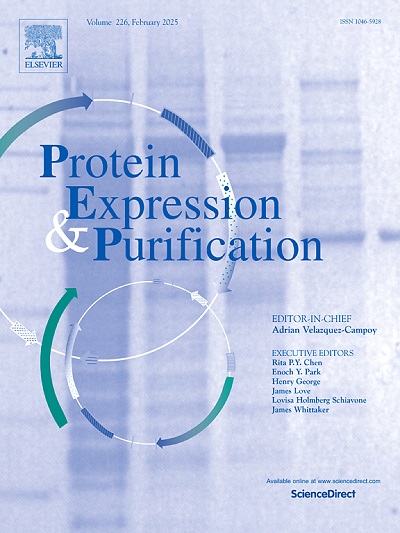Bioinformatics analysis and molecular cloning of squalene synthase from Simaroubaceae
IF 1.2
4区 生物学
Q4 BIOCHEMICAL RESEARCH METHODS
引用次数: 0
Abstract
Quassinoids are a class of highly oxygenated triterpenoids with C-18, C-19, C-20, C-22, or C-25 skeletons. Squalene synthase (SQS), a key enzyme in the quassinoids biosynthetic pathway, serves as the first step in controlling carbon flux flow into downstream quassinoids. In this study, we screened and analyzed the SQSs from the transcriptome data of the Simaroubaceae family, including AaSQS, BjSQS, AeSQS, QaSQS, ElSQS, and SaSQS. Bioinformatics analysis showed that these SQSs contain C-terminal transmembrane regions and exhibit over 80 % sequence identity with that of Glycyrrhiza glabra (GgSQS1). Phylogenetic analysis revealed that the SQSs from the Simaroubaceae family are more closely related to Malus domestica and Crataegus pinnatifida within the Rosales clade, suggesting an evolutionary trajectory that corroborates the taxonomic classification of Simaroubaceae within the Rosanae superorder. To characterize the function of the SQS from the Simaroubaceae family, the full-length AaSQS was cloned. A soluble AaSQS was obtained by expressing the truncated version lacking 24 amino acids at the C-terminal region in Escherichia coli. Functional analysis showed that AaSQS could catalyze the production of squalene from farnesyl pyrophosphate (FPP). Structural prediction and molecular docking indicated that residues S50, F51, L205, N209, R212, C286, P289, and M313 may be key catalytic residues in AaSQS. Further mutation analysis revealed that all mutants except C286A showed reduced squalene accumulation compared to the wild type (WT). These results provide guidance for quassinoid biosynthesis through metabolic engineering and synthetic biology strategies, particularly by engineering key amino acid residues to enhance enzymatic activity. This study advances the understanding of SQSs in the Simaroubaceae family and provides an important foundation for the study of quassinoid biosynthesis.
角鲨烯合成酶的生物信息学分析及分子克隆。
拟assinoids是一类具有C-18, C-19, C-20, C-22或C-25骨架的高氧三萜化合物。角鲨烯合成酶(Squalene synthase, SQS)是类星体生物合成途径中的关键酶,是控制碳通量流向下游类星体的第一步。在本研究中,我们从simmaroubacae科的转录组数据中筛选并分析了sqs,包括AaSQS、BjSQS、AeSQS、QaSQS、ElSQS和SaSQS。生物信息学分析表明,这些序列包含c端跨膜区,与Glycyrrhiza glabra (GgSQS1)序列同源性超过80%。系统发育分析表明,Simaroubaceae科的SQSs与Rosales分支中的Malus domestica和Crataegus pinnatifida亲缘关系更近,这一进化轨迹证实了Simaroubaceae在Rosanae超目中的分类学分类。为了进一步确定该基因的功能,对该基因进行了克隆。通过在大肠杆菌中表达c端缺失24个氨基酸的片段,获得了可溶性的AaSQS。功能分析表明,AaSQS可催化法尼酯焦磷酸(FPP)合成角鲨烯。结构预测和分子对接表明,S50、F51、L205、N209、R212、C286、P289和M313可能是AaSQS的关键催化残基。进一步的突变分析表明,与野生型(WT)相比,除C286A外,所有突变体的角鲨烯积累量都有所减少。这些结果为通过代谢工程和合成生物学策略,特别是通过工程设计关键氨基酸残基来增强酶活性提供了指导。该研究促进了人们对拟南芥科植物SQSs的认识,为拟南芥的生物合成研究提供了重要的基础。
本文章由计算机程序翻译,如有差异,请以英文原文为准。
求助全文
约1分钟内获得全文
求助全文
来源期刊

Protein expression and purification
生物-生化研究方法
CiteScore
3.70
自引率
6.20%
发文量
120
审稿时长
32 days
期刊介绍:
Protein Expression and Purification is an international journal providing a forum for the dissemination of new information on protein expression, extraction, purification, characterization, and/or applications using conventional biochemical and/or modern molecular biological approaches and methods, which are of broad interest to the field. The journal does not typically publish repetitive examples of protein expression and purification involving standard, well-established, methods. However, exceptions might include studies on important and/or difficult to express and/or purify proteins and/or studies that include extensive protein characterization, which provide new, previously unpublished information.
 求助内容:
求助内容: 应助结果提醒方式:
应助结果提醒方式:


